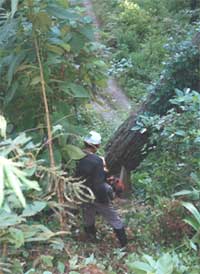
Inside the Yerba Buena
Cloud Forest Reserve
Among the most conspicuous trees in the forests around Yerba Buena are a tall, handsome species of pine and a smallish oak with leaves somewhat like our North American chestnut oaks. Maybe the most interesting feature of the forest is that three important tree species also are common trees in the deciduous forests of the eastern U. S. -- the very same species. Sweetgum, blackgum, and the American hornbeam are common here. These are relict populations from Ice Age times, when northern forests were shifted far to the south. When the ice withdrew, some of the northern species remained in the tropics simply by moving into the higher, colder elevations. The chart below shows temperature tendencies according to data collected over a year by Fred Adams of Colegio Linda Vista in the valley just below Yerba Buena.

Several dwarf and spiny species of palm lend the forest an exotic quality. Also there are several "strangler fig trees," which start out as vines but with time grow over their host tree and eventually "strangle" it, out-competing it for nutrients and sunlight, finally becoming very large, free-standing trees themselves. Branches of old trees often are festooned with lush, green gardens of orchid, bromeliad, fern and moss.
In l986, England's University of East Anglia sponsored a graduate-student project
resulting in several weeks of biological studies being conducted in Reserva Yerba Buena.
Their findings were published in a report entitled University of East Anglia Mexican
Rainforest Expedition l986.  (I cannot explain their
use of the word "Rainforest" in the title, for elsewhere in the publication they
use the proper designation, which is "cloud forest.") The accompanying rainfall
graph is based on data collected intermittently over several years by Fred Adams.
(I cannot explain their
use of the word "Rainforest" in the title, for elsewhere in the publication they
use the proper designation, which is "cloud forest.") The accompanying rainfall
graph is based on data collected intermittently over several years by Fred Adams.
Among mammals seen in the reserve and mentioned in the report were several species familiar to any U. S. nature- lover -- opossums, raccoons, whitetail deer, armadillos, hognose skunks, gray foxes, longtail weasels and Eastern cottontails. But also there were brocket deer (a pygmy species), peccaries (wild hogs), coatis (like a raccoon but with a very long, slender snout and tail), and kinkajous (a little like a monkey with a long, prehensile tail).
Only three kinds of lizard and six kinds of snake were found. One reason for this limited number probably was that the eruption of Chichonal in l982 left about six inches of ash blanketing the entire reserve, which must have been devastating for small, ground-dwelling animals.
However, a rainbow of birds survive in the reserve. The researchers spotted l04 species. Several species are migrants -- birds that breed in North America but overwinter in the tropics -- and would be familiar to most U. S. birdwatchers. The black and white warbler, worm-eating warbler, blue-winged warbler, yellow-throated warbler and Louisiana waterthrush, for instance, are birds that I frequently see in Kentucky. Of course, many other species were more "exotic." The white-faced quail-dove is a very secretive specialist of cloud forest undergrowth found only from southern Mexico to northern Nicaragua; the black penelopina is like a black, slender wild turkey; the blue- throated motmot is a long-tailed blue and green bird unlike anything we have in the U. S.; the blue-crowned chlorophonia, sparkling-tailed hummingbird, ruddy foliage-gleaner, spotted nightingale thrush, rufous-browed peppershrike, black-headed siskin... these are all birds that to a U. S. birdwatcher are exotic and spectacular. Once quetzals, perhaps the most spectacular of all Latin American birds -- the bird that supplied tail-feathers for the great Aztec kings' headdresses -- were common here. However, now they seem to have been completely exterminated in this area. Burton Comstock killed and stuffed a few of them, a couple dusty specimens of which still are mounted on the walls of Nela's house.